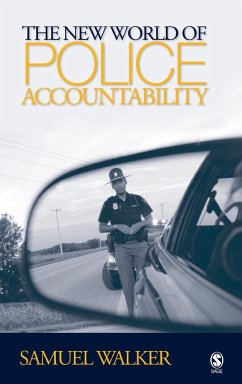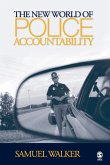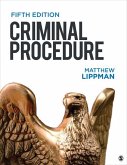Samuel E. Walker
The New World of Police Accountability
Samuel E. Walker
The New World of Police Accountability
- Gebundenes Buch
- Merkliste
- Auf die Merkliste
- Bewerten Bewerten
- Teilen
- Produkt teilen
- Produkterinnerung
- Produkterinnerung
The New World of Police Accountability is the first book to provide an original and comprehensive analysis of some of the most important developments in policing over the past ten years. Esteemed author Samuel Walker synthesizes the major developments in the area of police accountability and argues that these developments represent a new period in the history of police reform that promises to address the historic problems of police abuse. This text assesses both the achievements and limitations of police accountability and reshapes the conventional wisdom on this topic. The book covers such…mehr
Andere Kunden interessierten sich auch für
![The New World of Police Accountability The New World of Police Accountability]() Samuel E. WalkerThe New World of Police Accountability85,99 €
Samuel E. WalkerThe New World of Police Accountability85,99 €![Criminal Procedure Criminal Procedure]() Matthew LippmanCriminal Procedure189,99 €
Matthew LippmanCriminal Procedure189,99 €![Cybercrime and Society Cybercrime and Society]() Majid YarCybercrime and Society136,99 €
Majid YarCybercrime and Society136,99 €![Policing Policing]() John GrievePolicing48,99 €
John GrievePolicing48,99 €![Defund the Police Defund the Police]() Chris CunneenDefund the Police156,99 €
Chris CunneenDefund the Police156,99 €![Ethics and Accountability in Criminal Justice Ethics and Accountability in Criminal Justice]() Tim PrenzlerEthics and Accountability in Criminal Justice39,99 €
Tim PrenzlerEthics and Accountability in Criminal Justice39,99 €![The Jailer's Reckoning The Jailer's Reckoning]() Kevin B SmithThe Jailer's Reckoning25,99 €
Kevin B SmithThe Jailer's Reckoning25,99 €-
-
-
The New World of Police Accountability is the first book to provide an original and comprehensive analysis of some of the most important developments in policing over the past ten years. Esteemed author Samuel Walker synthesizes the major developments in the area of police accountability and argues that these developments represent a new period in the history of police reform that promises to address the historic problems of police abuse. This text assesses both the achievements and limitations of police accountability and reshapes the conventional wisdom on this topic. The book covers such issues as federal law suits against the police, consent decrees, citizen oversight of the police, and early intervention systems.
Hinweis: Dieser Artikel kann nur an eine deutsche Lieferadresse ausgeliefert werden.
Hinweis: Dieser Artikel kann nur an eine deutsche Lieferadresse ausgeliefert werden.
Produktdetails
- Produktdetails
- Verlag: Sage Publications, Inc
- Seitenzahl: 256
- Erscheinungstermin: 12. Januar 2005
- Englisch
- Abmessung: 235mm x 157mm x 18mm
- Gewicht: 526g
- ISBN-13: 9781412909433
- ISBN-10: 1412909430
- Artikelnr.: 22425074
- Herstellerkennzeichnung
- Produktsicherheitsverantwortliche/r
- Europaallee 1
- 36244 Bad Hersfeld
- gpsr@libri.de
- Verlag: Sage Publications, Inc
- Seitenzahl: 256
- Erscheinungstermin: 12. Januar 2005
- Englisch
- Abmessung: 235mm x 157mm x 18mm
- Gewicht: 526g
- ISBN-13: 9781412909433
- ISBN-10: 1412909430
- Artikelnr.: 22425074
- Herstellerkennzeichnung
- Produktsicherheitsverantwortliche/r
- Europaallee 1
- 36244 Bad Hersfeld
- gpsr@libri.de
Samuel Walker is Professor Emeritus of Criminal Justice at the University of Nebraska at Omaha. After retiring in 2005 he has continued his research, writing and consulting on police accountability, citizen oversight of the police, early intervention systems for police officers, and civil liberties. Professor Walker is the author of 14 books, which have appeared in 33 different editions. His most recent book is Presidents and Civil Liberties from Wilson to Obama (2012). His other books include The Police in America: An Introduction [with Charles M. Katz] (8th ed., 2013), Police Accountability: The Role of Citizen Oversight (2001), Taming the System: The Control of Discretion in Criminal Justice, 1950-1990 (1993), Sense and Nonsense About Crime (7th ed., 2011), The Color of Justice: Race, Ethnicity, and Crime in America (with C. Spohn & M. DeLone) (5th ed., 2003), and In Defense of American Liberties: A History of the ACLU (2nd ed., 2000). He is the author of Early Intervention Systems for Law Enforcement Agencies: A Planning and Management Guide (2003), published by the COPS Office of the U.S. Department of Justice. Professor Walker has served as a consultant to the Civil Rights Division of the U.S. Department of Justice and to police departments, local governments and community groups in over 35 cities and counties across the country on different police issues.
Preface Acknowledgments Chapter 1. Introduction to the New Police
Accountability Chapter 2. The Accomplishments and Limitations of Past
Police Reforms Chapter 3. Use of Force Reporting Chapter 4. An Open and
Accessible Citizen Complaint Procedure Chapter 5. Early Intervention
Systems Chapter 6. Police Auditors Chapter 7. The Future of the New Police
Accountability About the Author
Accountability Chapter 2. The Accomplishments and Limitations of Past
Police Reforms Chapter 3. Use of Force Reporting Chapter 4. An Open and
Accessible Citizen Complaint Procedure Chapter 5. Early Intervention
Systems Chapter 6. Police Auditors Chapter 7. The Future of the New Police
Accountability About the Author
Preface
Acknowledgments
About the Authors
PART I: INTRODUCTION TO THE NEW POLICE ACCOUNTABILITY
1. A National Police Crisis
Ferguson 2014: The Shooting of Michael Brown
A National Police Crisis
The New Conversation About Policing and Police Reform
The Challenge of Police Accountability
A Definition of Police Accountability
PTSR: A Framework for Accountability
Basic Themes in the New Police Accountability
The Challenge Ahead: Reasons for Hope, Reasons for Caution
2. The Accomplishments and Limits of Traditional Police Reforms
Introduction
The Police Professionalization Movement
The Courts and Police Reform
Legislative and Related Strategies for Police Reform
Conclusion: The Lessons of Past Reforms
PART II: THE ELEMENTS OF THE NEW POLICE ACCOUNTABILITY
3. The "Heart Of The Matter": Controlling Police Officer Use of Force
Introduction
Administrative Rulemaking: The Basic Model for Controlling Officer Conduct
Controlling Police Use of Deadly Force
Police Use of Less Lethal Force
Controlling Police Use of Physical Force
The Reporting and Investigation of Use of Force
De-Escalation as a Strategy for Limiting Use of Force
How Accountability-related Reforms Can Transform the Police Subculture
Conclusion
4. Controlling Critical Incidents
Introduction
Controlling Pedestrian Stops and Frisks
"Driving While Black": Traffic Stops and the Racial Profiling Controversy
Vehicle Pursuits: Reducing the Risks
Officer Foot Pursuits: Reducing the Risks
The Deployment of Canines: Reducing the Harms
Reducing Gender-Related Bias in Policing
Responding to Mental Health-Related Incidents
Achieving Bias-Free Policing
Ensuring Officer Integrity
Ensuring Officer Wellness
Guaranteeing People's First Amendment Rights
Conclusion
5. Public Complaints and Police Accountability
Introduction
A Short History of Public Complaints, Internal Affairs Units, and Public Oversight
Basic Issues of Complaints and Complaint Investigations
The Public Complaint Process
Accepting, Recording, Screening, and Classifying Complaints
Investigating Complaints
The Disposition of Complaints
Ensuring the Quality of the Complaint Process
Staffing and Managing the Complaint Process
Evaluating the Complaint Process
Conclusion
6. Early Intervention Systems
Introduction
The Background and Development of the EIS Concept
Basic Issues in Early Intervention Systems
The Basic Requirements for an EIS
The Components of an EIS
The Challenge of Implementing an Early Intervention System
Impacts of an Early Intervention System
The Effectiveness of Early Intervention Systems
The Experiences and Perceptions of EIS Police Managers
Conclusion
7. External Review of the Police
Introduction
Basic Features of Police Auditors and Inspectors General
The Work of the Inspector General for the NYPD
The San Jose Independent Police Auditor
The Los Angeles Police Commission and Inspector General
The Washington, DC, Office of Police Complaints
A Lost Agency: The Special Counsel to the Los Angeles Sheriff's Department
Blue-Ribbon Commissions
The Strengths and Limits of External Review
Another Lost Program: The Collaborative Reform Initiative
Conclusion
PART III: CONTEMPORARY ISSUES IN ACCOUNTABILITY
8. Increasing Accountability with Risk Management
What is Risk Management?
Risk Management, Police Liability, and Accountability
Early Intervention Systems and Risk Management
The Prevalence of Risk Management in American Policing
Research on Risk Management in Policing
Barriers to the Implementation of Risk Management
Overcoming Barriers to Implementation: The Case of Risk Management in Medicine
Innovative Risk Management in Risk Management in Medicine: The Checklist
Checklists and Policing: Could it Work?
Legalized Accountability and Police Reform
Insurance Companies as Accountability Agents
Looking Ahead: The Future of Risk Management in Policing
9. Police Accountability and Technology
Introduction
Video-Recording Devices Used by the Public
Using Apps to Report Police Misconduct
Video-Recording Devices Used by the Police
Compliance With Body-Worn Camera Activation Policies
Perceptions of Police Body Cameras
Using Social Media to Inform the Public of Police Misconduct
Increasing Police Accountability with Open Data
The Future of Technology and Police Accountability
PART IV: THE FUTURE OF POLICE ACCOUNTABILITY
10. The Future of Police Accountability
The National Police Crisis and its Impact
Progress: "Best Practices" Today
Threats to the Future of Police Accountability
Final Thoughts
Index
Acknowledgments
About the Authors
PART I: INTRODUCTION TO THE NEW POLICE ACCOUNTABILITY
1. A National Police Crisis
Ferguson 2014: The Shooting of Michael Brown
A National Police Crisis
The New Conversation About Policing and Police Reform
The Challenge of Police Accountability
A Definition of Police Accountability
PTSR: A Framework for Accountability
Basic Themes in the New Police Accountability
The Challenge Ahead: Reasons for Hope, Reasons for Caution
2. The Accomplishments and Limits of Traditional Police Reforms
Introduction
The Police Professionalization Movement
The Courts and Police Reform
Legislative and Related Strategies for Police Reform
Conclusion: The Lessons of Past Reforms
PART II: THE ELEMENTS OF THE NEW POLICE ACCOUNTABILITY
3. The "Heart Of The Matter": Controlling Police Officer Use of Force
Introduction
Administrative Rulemaking: The Basic Model for Controlling Officer Conduct
Controlling Police Use of Deadly Force
Police Use of Less Lethal Force
Controlling Police Use of Physical Force
The Reporting and Investigation of Use of Force
De-Escalation as a Strategy for Limiting Use of Force
How Accountability-related Reforms Can Transform the Police Subculture
Conclusion
4. Controlling Critical Incidents
Introduction
Controlling Pedestrian Stops and Frisks
"Driving While Black": Traffic Stops and the Racial Profiling Controversy
Vehicle Pursuits: Reducing the Risks
Officer Foot Pursuits: Reducing the Risks
The Deployment of Canines: Reducing the Harms
Reducing Gender-Related Bias in Policing
Responding to Mental Health-Related Incidents
Achieving Bias-Free Policing
Ensuring Officer Integrity
Ensuring Officer Wellness
Guaranteeing People's First Amendment Rights
Conclusion
5. Public Complaints and Police Accountability
Introduction
A Short History of Public Complaints, Internal Affairs Units, and Public Oversight
Basic Issues of Complaints and Complaint Investigations
The Public Complaint Process
Accepting, Recording, Screening, and Classifying Complaints
Investigating Complaints
The Disposition of Complaints
Ensuring the Quality of the Complaint Process
Staffing and Managing the Complaint Process
Evaluating the Complaint Process
Conclusion
6. Early Intervention Systems
Introduction
The Background and Development of the EIS Concept
Basic Issues in Early Intervention Systems
The Basic Requirements for an EIS
The Components of an EIS
The Challenge of Implementing an Early Intervention System
Impacts of an Early Intervention System
The Effectiveness of Early Intervention Systems
The Experiences and Perceptions of EIS Police Managers
Conclusion
7. External Review of the Police
Introduction
Basic Features of Police Auditors and Inspectors General
The Work of the Inspector General for the NYPD
The San Jose Independent Police Auditor
The Los Angeles Police Commission and Inspector General
The Washington, DC, Office of Police Complaints
A Lost Agency: The Special Counsel to the Los Angeles Sheriff's Department
Blue-Ribbon Commissions
The Strengths and Limits of External Review
Another Lost Program: The Collaborative Reform Initiative
Conclusion
PART III: CONTEMPORARY ISSUES IN ACCOUNTABILITY
8. Increasing Accountability with Risk Management
What is Risk Management?
Risk Management, Police Liability, and Accountability
Early Intervention Systems and Risk Management
The Prevalence of Risk Management in American Policing
Research on Risk Management in Policing
Barriers to the Implementation of Risk Management
Overcoming Barriers to Implementation: The Case of Risk Management in Medicine
Innovative Risk Management in Risk Management in Medicine: The Checklist
Checklists and Policing: Could it Work?
Legalized Accountability and Police Reform
Insurance Companies as Accountability Agents
Looking Ahead: The Future of Risk Management in Policing
9. Police Accountability and Technology
Introduction
Video-Recording Devices Used by the Public
Using Apps to Report Police Misconduct
Video-Recording Devices Used by the Police
Compliance With Body-Worn Camera Activation Policies
Perceptions of Police Body Cameras
Using Social Media to Inform the Public of Police Misconduct
Increasing Police Accountability with Open Data
The Future of Technology and Police Accountability
PART IV: THE FUTURE OF POLICE ACCOUNTABILITY
10. The Future of Police Accountability
The National Police Crisis and its Impact
Progress: "Best Practices" Today
Threats to the Future of Police Accountability
Final Thoughts
Index
Preface Acknowledgments Chapter 1. Introduction to the New Police
Accountability Chapter 2. The Accomplishments and Limitations of Past
Police Reforms Chapter 3. Use of Force Reporting Chapter 4. An Open and
Accessible Citizen Complaint Procedure Chapter 5. Early Intervention
Systems Chapter 6. Police Auditors Chapter 7. The Future of the New Police
Accountability About the Author
Accountability Chapter 2. The Accomplishments and Limitations of Past
Police Reforms Chapter 3. Use of Force Reporting Chapter 4. An Open and
Accessible Citizen Complaint Procedure Chapter 5. Early Intervention
Systems Chapter 6. Police Auditors Chapter 7. The Future of the New Police
Accountability About the Author
Preface
Acknowledgments
About the Authors
PART I: INTRODUCTION TO THE NEW POLICE ACCOUNTABILITY
1. A National Police Crisis
Ferguson 2014: The Shooting of Michael Brown
A National Police Crisis
The New Conversation About Policing and Police Reform
The Challenge of Police Accountability
A Definition of Police Accountability
PTSR: A Framework for Accountability
Basic Themes in the New Police Accountability
The Challenge Ahead: Reasons for Hope, Reasons for Caution
2. The Accomplishments and Limits of Traditional Police Reforms
Introduction
The Police Professionalization Movement
The Courts and Police Reform
Legislative and Related Strategies for Police Reform
Conclusion: The Lessons of Past Reforms
PART II: THE ELEMENTS OF THE NEW POLICE ACCOUNTABILITY
3. The "Heart Of The Matter": Controlling Police Officer Use of Force
Introduction
Administrative Rulemaking: The Basic Model for Controlling Officer Conduct
Controlling Police Use of Deadly Force
Police Use of Less Lethal Force
Controlling Police Use of Physical Force
The Reporting and Investigation of Use of Force
De-Escalation as a Strategy for Limiting Use of Force
How Accountability-related Reforms Can Transform the Police Subculture
Conclusion
4. Controlling Critical Incidents
Introduction
Controlling Pedestrian Stops and Frisks
"Driving While Black": Traffic Stops and the Racial Profiling Controversy
Vehicle Pursuits: Reducing the Risks
Officer Foot Pursuits: Reducing the Risks
The Deployment of Canines: Reducing the Harms
Reducing Gender-Related Bias in Policing
Responding to Mental Health-Related Incidents
Achieving Bias-Free Policing
Ensuring Officer Integrity
Ensuring Officer Wellness
Guaranteeing People's First Amendment Rights
Conclusion
5. Public Complaints and Police Accountability
Introduction
A Short History of Public Complaints, Internal Affairs Units, and Public Oversight
Basic Issues of Complaints and Complaint Investigations
The Public Complaint Process
Accepting, Recording, Screening, and Classifying Complaints
Investigating Complaints
The Disposition of Complaints
Ensuring the Quality of the Complaint Process
Staffing and Managing the Complaint Process
Evaluating the Complaint Process
Conclusion
6. Early Intervention Systems
Introduction
The Background and Development of the EIS Concept
Basic Issues in Early Intervention Systems
The Basic Requirements for an EIS
The Components of an EIS
The Challenge of Implementing an Early Intervention System
Impacts of an Early Intervention System
The Effectiveness of Early Intervention Systems
The Experiences and Perceptions of EIS Police Managers
Conclusion
7. External Review of the Police
Introduction
Basic Features of Police Auditors and Inspectors General
The Work of the Inspector General for the NYPD
The San Jose Independent Police Auditor
The Los Angeles Police Commission and Inspector General
The Washington, DC, Office of Police Complaints
A Lost Agency: The Special Counsel to the Los Angeles Sheriff's Department
Blue-Ribbon Commissions
The Strengths and Limits of External Review
Another Lost Program: The Collaborative Reform Initiative
Conclusion
PART III: CONTEMPORARY ISSUES IN ACCOUNTABILITY
8. Increasing Accountability with Risk Management
What is Risk Management?
Risk Management, Police Liability, and Accountability
Early Intervention Systems and Risk Management
The Prevalence of Risk Management in American Policing
Research on Risk Management in Policing
Barriers to the Implementation of Risk Management
Overcoming Barriers to Implementation: The Case of Risk Management in Medicine
Innovative Risk Management in Risk Management in Medicine: The Checklist
Checklists and Policing: Could it Work?
Legalized Accountability and Police Reform
Insurance Companies as Accountability Agents
Looking Ahead: The Future of Risk Management in Policing
9. Police Accountability and Technology
Introduction
Video-Recording Devices Used by the Public
Using Apps to Report Police Misconduct
Video-Recording Devices Used by the Police
Compliance With Body-Worn Camera Activation Policies
Perceptions of Police Body Cameras
Using Social Media to Inform the Public of Police Misconduct
Increasing Police Accountability with Open Data
The Future of Technology and Police Accountability
PART IV: THE FUTURE OF POLICE ACCOUNTABILITY
10. The Future of Police Accountability
The National Police Crisis and its Impact
Progress: "Best Practices" Today
Threats to the Future of Police Accountability
Final Thoughts
Index
Acknowledgments
About the Authors
PART I: INTRODUCTION TO THE NEW POLICE ACCOUNTABILITY
1. A National Police Crisis
Ferguson 2014: The Shooting of Michael Brown
A National Police Crisis
The New Conversation About Policing and Police Reform
The Challenge of Police Accountability
A Definition of Police Accountability
PTSR: A Framework for Accountability
Basic Themes in the New Police Accountability
The Challenge Ahead: Reasons for Hope, Reasons for Caution
2. The Accomplishments and Limits of Traditional Police Reforms
Introduction
The Police Professionalization Movement
The Courts and Police Reform
Legislative and Related Strategies for Police Reform
Conclusion: The Lessons of Past Reforms
PART II: THE ELEMENTS OF THE NEW POLICE ACCOUNTABILITY
3. The "Heart Of The Matter": Controlling Police Officer Use of Force
Introduction
Administrative Rulemaking: The Basic Model for Controlling Officer Conduct
Controlling Police Use of Deadly Force
Police Use of Less Lethal Force
Controlling Police Use of Physical Force
The Reporting and Investigation of Use of Force
De-Escalation as a Strategy for Limiting Use of Force
How Accountability-related Reforms Can Transform the Police Subculture
Conclusion
4. Controlling Critical Incidents
Introduction
Controlling Pedestrian Stops and Frisks
"Driving While Black": Traffic Stops and the Racial Profiling Controversy
Vehicle Pursuits: Reducing the Risks
Officer Foot Pursuits: Reducing the Risks
The Deployment of Canines: Reducing the Harms
Reducing Gender-Related Bias in Policing
Responding to Mental Health-Related Incidents
Achieving Bias-Free Policing
Ensuring Officer Integrity
Ensuring Officer Wellness
Guaranteeing People's First Amendment Rights
Conclusion
5. Public Complaints and Police Accountability
Introduction
A Short History of Public Complaints, Internal Affairs Units, and Public Oversight
Basic Issues of Complaints and Complaint Investigations
The Public Complaint Process
Accepting, Recording, Screening, and Classifying Complaints
Investigating Complaints
The Disposition of Complaints
Ensuring the Quality of the Complaint Process
Staffing and Managing the Complaint Process
Evaluating the Complaint Process
Conclusion
6. Early Intervention Systems
Introduction
The Background and Development of the EIS Concept
Basic Issues in Early Intervention Systems
The Basic Requirements for an EIS
The Components of an EIS
The Challenge of Implementing an Early Intervention System
Impacts of an Early Intervention System
The Effectiveness of Early Intervention Systems
The Experiences and Perceptions of EIS Police Managers
Conclusion
7. External Review of the Police
Introduction
Basic Features of Police Auditors and Inspectors General
The Work of the Inspector General for the NYPD
The San Jose Independent Police Auditor
The Los Angeles Police Commission and Inspector General
The Washington, DC, Office of Police Complaints
A Lost Agency: The Special Counsel to the Los Angeles Sheriff's Department
Blue-Ribbon Commissions
The Strengths and Limits of External Review
Another Lost Program: The Collaborative Reform Initiative
Conclusion
PART III: CONTEMPORARY ISSUES IN ACCOUNTABILITY
8. Increasing Accountability with Risk Management
What is Risk Management?
Risk Management, Police Liability, and Accountability
Early Intervention Systems and Risk Management
The Prevalence of Risk Management in American Policing
Research on Risk Management in Policing
Barriers to the Implementation of Risk Management
Overcoming Barriers to Implementation: The Case of Risk Management in Medicine
Innovative Risk Management in Risk Management in Medicine: The Checklist
Checklists and Policing: Could it Work?
Legalized Accountability and Police Reform
Insurance Companies as Accountability Agents
Looking Ahead: The Future of Risk Management in Policing
9. Police Accountability and Technology
Introduction
Video-Recording Devices Used by the Public
Using Apps to Report Police Misconduct
Video-Recording Devices Used by the Police
Compliance With Body-Worn Camera Activation Policies
Perceptions of Police Body Cameras
Using Social Media to Inform the Public of Police Misconduct
Increasing Police Accountability with Open Data
The Future of Technology and Police Accountability
PART IV: THE FUTURE OF POLICE ACCOUNTABILITY
10. The Future of Police Accountability
The National Police Crisis and its Impact
Progress: "Best Practices" Today
Threats to the Future of Police Accountability
Final Thoughts
Index








